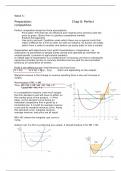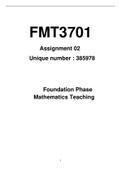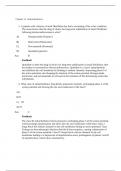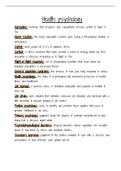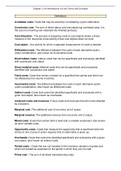Binomial Distribution
Binomial Experiment-
A binomial experiment (also known as a Bernoulli trial) is a statistical experiment that has the followin
The experiment consists of n repeated trials.
Each trial can result in just two possible outcomes. We call one of these outcomes a success and the ot
The probability of success, denoted by P, is the same on every trial.
The trials are independent; that is, the outcome on one trial does not affect the outcome on other tria
Consider the following statistical experiment. You flip a coin 2 times and count the number of times the coin l
experiment because:
The experiment consists of repeated trials. We flip a coin 2 times.
Each trial can result in just two possible outcomes - heads or tails.
The probability of success is constant - 0.5 on every trial.
The trials are independent; that is, getting heads on one trial does not affect whether we get heads on
Notation
The following notation is helpful, when we talk about binomial probability.
k: The number of successes that result from the binomial experiment.
n: The number of trials in the binomial experiment.
P: The probability of success on an individual trial.
Q: The probability of failure on an individual trial. (This is equal to 1 - P)
Binomial Distribution
A binomial random variable is the number of successes x in n repeated trials of a binomial experiment. The pr
random variable is called a binomial distribution.
Probability Mass function, b(k; n, P) = f ( k ) = ( n k ) p^k * ( 1- p) ^ n-k
Where
k = number of successes in trials
n = is the number of independent trials
p = probability of success on each trial
Mean of binomial = np
Standard deviation of Binomial = Sqrt ( npq )
Problems
1)
In a Certain college 33% of the physics majors belong to ethnic minorities, If 10 students are selected at random from t
than no more than 6 belongs to ethnic community?
Ans -
,2)
Ans -
a)
P( X = 3 ) = ( 9 3 ) * ( 0.51^3) * ( 1 - 0.51 )^6
= 0.15423
b)
P( X > 3) = 1 - P ( X <=3) = 1 -0.2346 = 0.7654
c)
P( X > = 3 ) = P(X > 3) + P (X = 3) = 0.9196
d)
P( X < = 3) = P(X=3) + P(X=2) + P(X=1) + P(X=0)
= ( 9 3 ) * 0.51^3 * ( 1- 0.51 ) ^6 + ( 9 2 ) * 0.51^2 * ( 1- 0.51 ) ^7 + ( 9 1 ) * 0.51^1 * ( 1- 0.51 ) ^8 + ( 9 0 ) * 0
= 0.2346
e)
P( X < 3) = P(X=2) + P(X=1) + P(X=0) +
= ( 9 2 ) * 0.51^2 * ( 1- 0.51 ) ^7 + ( 9 1 ) * 0.51^1 * ( 1- 0.51 ) ^8 + ( 9 0 ) * 0.51^0 * ( 1- 0.51 ) ^9
= 0.0804
3)
The Centre for Disease Control has determined that when a person is given a vaccine, the probability that the person wi
people are given
the vaccine, find the probability that ...
(a) ... four will develop immunity.
(b) ... all will develop immunity.
Ans -
(a)
Binomial Distribution
PMF of B.D is = f ( k ) = ( n k ) p^k * ( 1- p) ^ n-k
Where
k = number of successes in trials
n = is the number of independent trials
p = probability of success on each trial
Will consider the probability of success rate for 4 people
, Using Excel It can be calculated with below formula : NORM.INV(probability,mean,standard_dev) ,
Eg:
0.05 Los for a two tailed test we use “NORM.INV ( 0.05/2,0,1)”
0.05 Los for a one tailed test we use “NORM.INV ( 0.05,0,1)”
The result of that division is the Z score of the chosen sample, indicating how many standard deviations away fro
Z score is positive, then it tells you how many standard deviations above the mean the sample lies; if it is negative, then
below the mean the sample lies
A typical curve look as below
When P(Z ≤ a)
When P(Z ≥ a)
Binomial Experiment-
A binomial experiment (also known as a Bernoulli trial) is a statistical experiment that has the followin
The experiment consists of n repeated trials.
Each trial can result in just two possible outcomes. We call one of these outcomes a success and the ot
The probability of success, denoted by P, is the same on every trial.
The trials are independent; that is, the outcome on one trial does not affect the outcome on other tria
Consider the following statistical experiment. You flip a coin 2 times and count the number of times the coin l
experiment because:
The experiment consists of repeated trials. We flip a coin 2 times.
Each trial can result in just two possible outcomes - heads or tails.
The probability of success is constant - 0.5 on every trial.
The trials are independent; that is, getting heads on one trial does not affect whether we get heads on
Notation
The following notation is helpful, when we talk about binomial probability.
k: The number of successes that result from the binomial experiment.
n: The number of trials in the binomial experiment.
P: The probability of success on an individual trial.
Q: The probability of failure on an individual trial. (This is equal to 1 - P)
Binomial Distribution
A binomial random variable is the number of successes x in n repeated trials of a binomial experiment. The pr
random variable is called a binomial distribution.
Probability Mass function, b(k; n, P) = f ( k ) = ( n k ) p^k * ( 1- p) ^ n-k
Where
k = number of successes in trials
n = is the number of independent trials
p = probability of success on each trial
Mean of binomial = np
Standard deviation of Binomial = Sqrt ( npq )
Problems
1)
In a Certain college 33% of the physics majors belong to ethnic minorities, If 10 students are selected at random from t
than no more than 6 belongs to ethnic community?
Ans -
,2)
Ans -
a)
P( X = 3 ) = ( 9 3 ) * ( 0.51^3) * ( 1 - 0.51 )^6
= 0.15423
b)
P( X > 3) = 1 - P ( X <=3) = 1 -0.2346 = 0.7654
c)
P( X > = 3 ) = P(X > 3) + P (X = 3) = 0.9196
d)
P( X < = 3) = P(X=3) + P(X=2) + P(X=1) + P(X=0)
= ( 9 3 ) * 0.51^3 * ( 1- 0.51 ) ^6 + ( 9 2 ) * 0.51^2 * ( 1- 0.51 ) ^7 + ( 9 1 ) * 0.51^1 * ( 1- 0.51 ) ^8 + ( 9 0 ) * 0
= 0.2346
e)
P( X < 3) = P(X=2) + P(X=1) + P(X=0) +
= ( 9 2 ) * 0.51^2 * ( 1- 0.51 ) ^7 + ( 9 1 ) * 0.51^1 * ( 1- 0.51 ) ^8 + ( 9 0 ) * 0.51^0 * ( 1- 0.51 ) ^9
= 0.0804
3)
The Centre for Disease Control has determined that when a person is given a vaccine, the probability that the person wi
people are given
the vaccine, find the probability that ...
(a) ... four will develop immunity.
(b) ... all will develop immunity.
Ans -
(a)
Binomial Distribution
PMF of B.D is = f ( k ) = ( n k ) p^k * ( 1- p) ^ n-k
Where
k = number of successes in trials
n = is the number of independent trials
p = probability of success on each trial
Will consider the probability of success rate for 4 people
, Using Excel It can be calculated with below formula : NORM.INV(probability,mean,standard_dev) ,
Eg:
0.05 Los for a two tailed test we use “NORM.INV ( 0.05/2,0,1)”
0.05 Los for a one tailed test we use “NORM.INV ( 0.05,0,1)”
The result of that division is the Z score of the chosen sample, indicating how many standard deviations away fro
Z score is positive, then it tells you how many standard deviations above the mean the sample lies; if it is negative, then
below the mean the sample lies
A typical curve look as below
When P(Z ≤ a)
When P(Z ≥ a)

